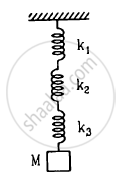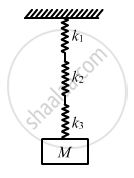Advertisements
Advertisements
प्रश्न
Find the elastic potential energy stored in each spring shown in figure when the block is in equilibrium. Also find the time period of vertical oscillation of the block.

उत्तर

All three spring attached to the mass M are in series.
k1, k2, k3 are the spring constants.
Let k be the resultant spring constant.
\[\frac{1}{k} = \frac{1}{k_1} + \frac{1}{k_2} + \frac{1}{k_3}\]
\[ \Rightarrow k = \frac{k_1 k_2 k_3}{k_1 k_2 + k_2 k_3 + k_3 k_1}\]
\[\text { Time period }\left( T \right)\text{ is given by, }\]
\[T = 2\pi\sqrt{\frac{M}{k}}\]
\[ = 2\sqrt{\frac{M\left( k_1 k_2 + k_2 k_3 + k_3 k_1 \right)}{k_1 k_2 k_3}}\]
\[ = 2\sqrt{M\left( \frac{1}{k_1} + \frac{1}{k_2} + \frac{1}{k_3} \right)}\]
As force is equal to the weight of the body,
F = weight = Mg
Let x1, x2, and x3 be the displacements of the springs having spring constants k1, k2 andk3 respectively.
For spring k1,
\[x_1 = \frac{Mg}{k_1}\]
\[\text { Similarly }, x_2 = \frac{Mg}{k_2}\]
\[\text { and } x_3 = \frac{Mg}{k_3}\]
\[ \therefore {PE}_1 = \frac{1}{2} k_1 x_1^2 \]
\[ = \frac{1}{2} k_1 \left( \frac{Mg}{k_1} \right)^2 \]
\[ = \frac{1}{2} k_1 \frac{M^2 g^2}{k_1^2}\]
\[ = \frac{1}{2}\frac{M^2 g^2}{k_1} = \frac{M^2 g^2}{2 k_1}\]
\[\text { Similarly }, {PE}_2 = \frac{M^2 g^2}{2 k_2}\]
\[\text { and } {PE}_3 = \frac{M^2 g^2}{2 k_3}\]
APPEARS IN
संबंधित प्रश्न
A particle is in linear simple harmonic motion between two points, A and B, 10 cm apart. Take the direction from A to B as the positive direction and give the signs of velocity, acceleration and force on the particle when it is
(a) at the end A,
(b) at the end B,
(c) at the mid-point of AB going towards A,
(d) at 2 cm away from B going towards A,
(e) at 3 cm away from A going towards B, and
(f) at 4 cm away from B going towards A.
A particle executes simple harmonic motion with an amplitude of 10 cm. At what distance from the mean position are the kinetic and potential energies equal?
Consider a particle moving in simple harmonic motion according to the equation x = 2.0 cos (50 πt + tan−1 0.75) where x is in centimetre and t in second. The motion is started at t = 0. (a) When does the particle come to rest for the first time? (b) When does he acceleration have its maximum magnitude for the first time? (c) When does the particle come to rest for the second time ?
A block suspended from a vertical spring is in equilibrium. Show that the extension of the spring equals the length of an equivalent simple pendulum, i.e., a pendulum having frequency same as that of the block.
A block of mass 0.5 kg hanging from a vertical spring executes simple harmonic motion of amplitude 0.1 m and time period 0.314 s. Find the maximum force exerted by the spring on the block.
The block of mass m1 shown in figure is fastened to the spring and the block of mass m2 is placed against it. (a) Find the compression of the spring in the equilibrium position. (b) The blocks are pushed a further distance (2/k) (m1 + m2)g sin θ against the spring and released. Find the position where the two blocks separate. (c) What is the common speed of blocks at the time of separation?

In following figure k = 100 N/m M = 1 kg and F = 10 N.
- Find the compression of the spring in the equilibrium position.
- A sharp blow by some external agent imparts a speed of 2 m/s to the block towards left. Find the sum of the potential energy of the spring and the kinetic energy of the block at this instant.
- Find the time period of the resulting simple harmonic motion.
- Find the amplitude.
- Write the potential energy of the spring when the block is at the left extreme.
- Write the potential energy of the spring when the block is at the right extreme.
The answer of b, e and f are different. Explain why this does not violate the principle of conservation of energy.

A rectangle plate of sides a and b is suspended from a ceiling by two parallel string of length L each in Figure . The separation between the string is d. The plate is displaced slightly in its plane keeping the strings tight. Show that it will execute simple harmonic motion. Find the time period.

Discuss in detail the energy in simple harmonic motion.
When a particle executing S.H.M oscillates with a frequency v, then the kinetic energy of the particle?
When the displacement of a particle executing simple harmonic motion is half its amplitude, the ratio of its kinetic energy to potential energy is ______.
If a body is executing simple harmonic motion and its current displacements is `sqrt3/2` times the amplitude from its mean position, then the ratio between potential energy and kinetic energy is:
Motion of an oscillating liquid column in a U-tube is ______.
A body is performing S.H.M. Then its ______.
- average total energy per cycle is equal to its maximum kinetic energy.
- average kinetic energy per cycle is equal to half of its maximum kinetic energy.
- mean velocity over a complete cycle is equal to `2/π` times of its π maximum velocity.
- root mean square velocity is times of its maximum velocity `1/sqrt(2)`.
Displacement versus time curve for a particle executing S.H.M. is shown in figure. Identify the points marked at which (i) velocity of the oscillator is zero, (ii) speed of the oscillator is maximum.

A mass of 2 kg is attached to the spring of spring constant 50 Nm–1. The block is pulled to a distance of 5 cm from its equilibrium position at x = 0 on a horizontal frictionless surface from rest at t = 0. Write the expression for its displacement at anytime t.
